Music has a profound impact on a child’s development, and introducing musical instruments at an early age can have numerous benefits. One instrument that stands out for its simplicity, beautiful tones, and easy to learn is the xylophone.
Xylophones offer a great way for toddlers to explore and express their musical talents while enjoying a fun and interactive experience. But getting a xylophone for your toddler isn’t as simple as you might think. I’ve spent plenty of money on toy xylophones that end up broken and in the junk pile.
Let us save you the headache! Don’t waste your money on a xylophone that’s just going to fall apart! Be sure to read to the end to see which brands to avoid.
Top 5 Best Xylophones for Your Toddler
Investing in a good quality xylophone for your child is more than just a purchase; it’s an investment in their safety, musical education, and overall enjoyment.
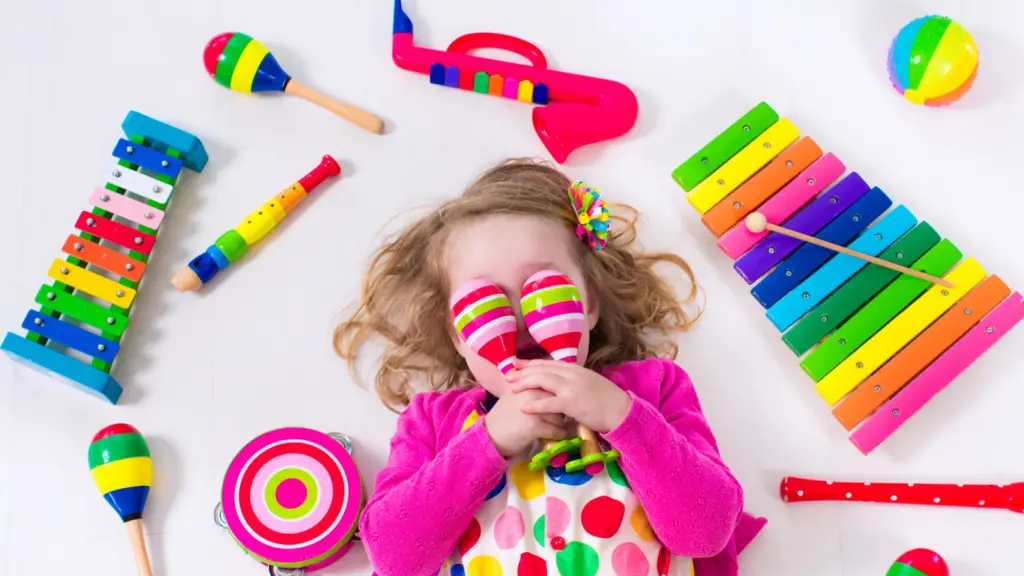
1. Fisher-Price Toddler Pull Toy, Classic Xylophone
A Classic that has held up for years and years!
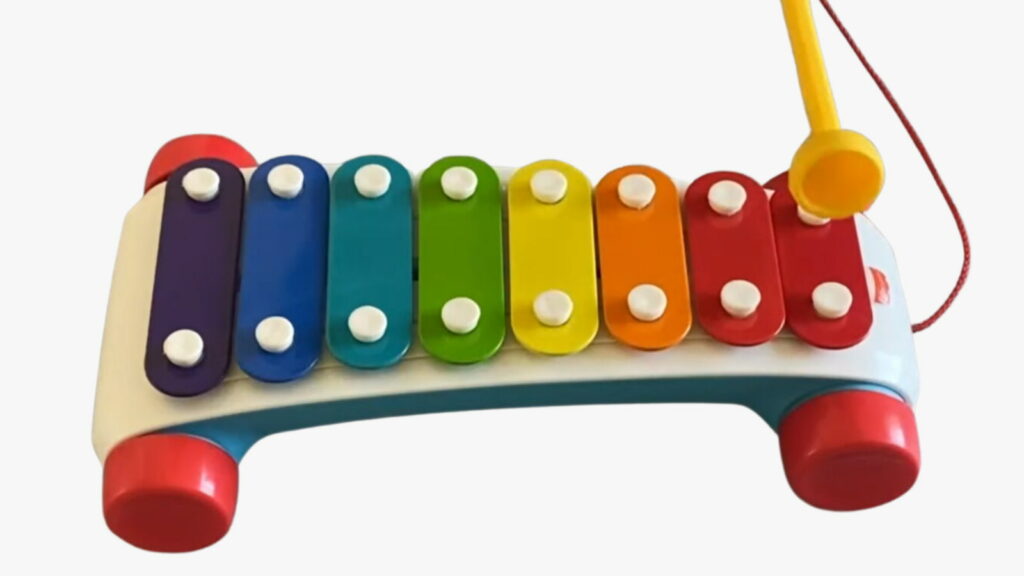
Why we love it!
- Quality and Durability
- Mallet won’t get lost
- BPA, PVC free
- No Splinters
- Classic Design
This Fisher Price Xylophone for toddlers is made by one of the most trusted brands in the industry with a long-standing reputation for quality and durability.
I like how the string makes it a fun toy for my toddler to pull around the room, but not only that it helps keep the mallet from getting lost. We all know how easy it is for toys that have several parts to get lost from each other.
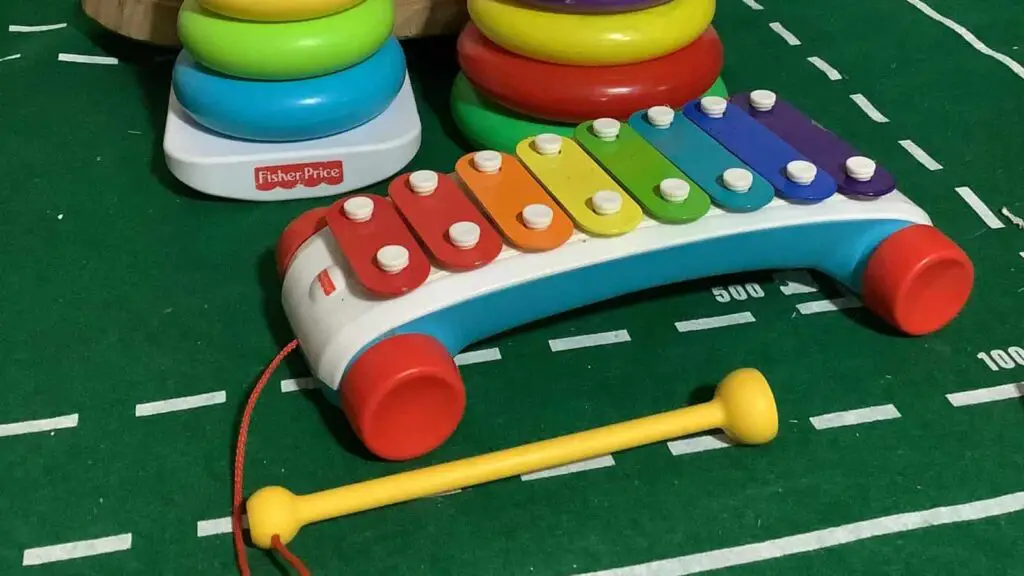
Note: The one complaint we have and have seen from other parents is that the string should be an inch or two longer. We solved that problem by just replacing it and adding our own string.
2. Xylophone Music Toy from Small Fish
Why we love it!
- Amazing Sound Quality
- Easy Grip Mallets
- Comes with Music
- Free Harmonica
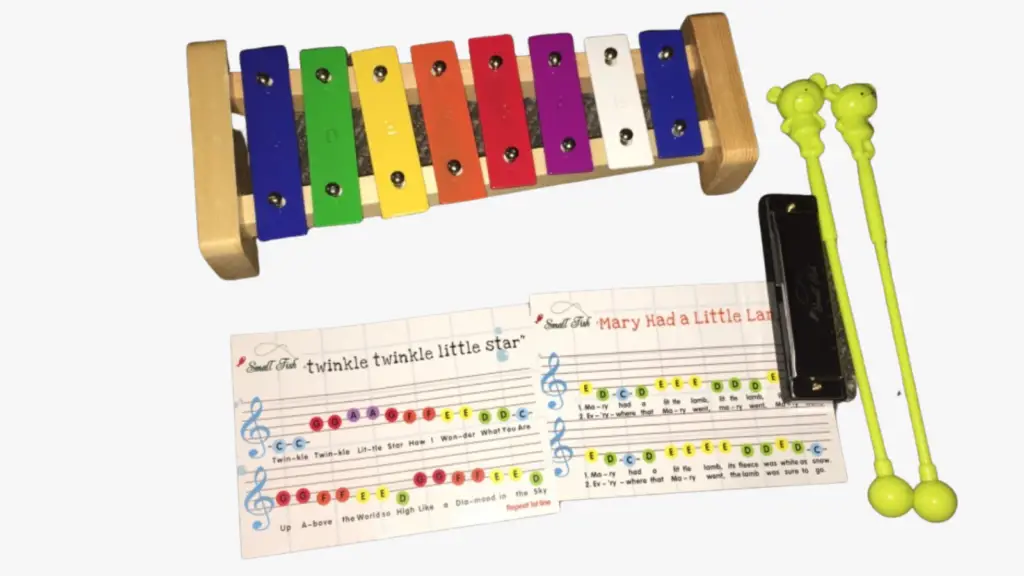
Of all the xylophones on our list, this one has the BEST sound quality. It’s tuned right on pitch which makes it easy to create beautiful melodies that are very recognizable. At first, we were a bit concerned about it being made from wood, but it has nice smooth edges with no chance of breaking or splintering.
You can hear the sound of this Xylophone in this video. Also, this YouTube channel has a lot of fun xylophone play-along songs that your toddler could easily learn by choosing this same xylophone.
Note: If there was one thing I could change about this one, I would like the mallets to be just a little bit shorter and a little bit thicker to make it easier for my toddler to hold on to them.
3. Montessori Wooden Hammer Xylophone
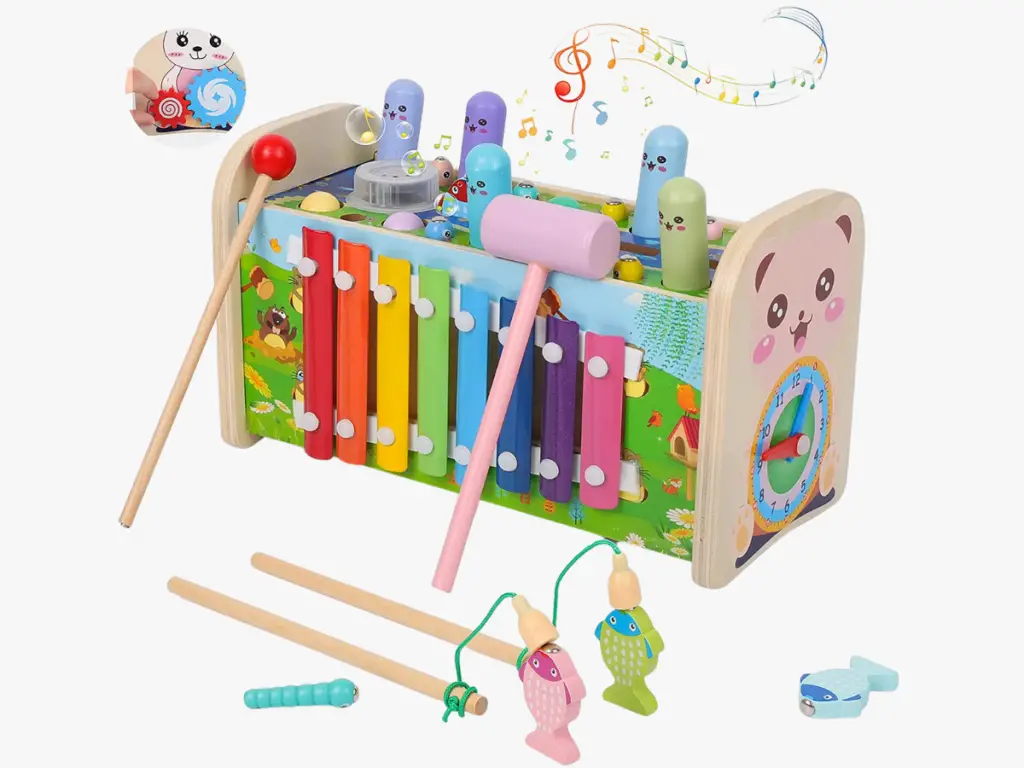
Why we love it!
- It’s Montessori
- It’s incredibly versatile
- 8 different activities
- Safe materials
You’ll absolutely love this Rabing Pounding Bench xylophone for its incredible versatility and educational value. This 8-in-1 wooden educational toy offers a range of engaging activities, from tapping the colored heads to enhance strength and reaction skills, to maneuvering gears to develop fine finger flexibility.
Crafted from child-safe materials, this bench ensures both safety and hours of educational fun.
The xylophone encourages a sense of rhythm and sound exploration, while additional games like fishing and caterpillar catching foster motor skills and problem-solving abilities. Rooted in the Montessori approach, this toy aids in color discrimination, motor skill development, and imaginative thinking.
4. Toysery 2 In 1 Piano Xylophone
A two in one xylophone and piano!
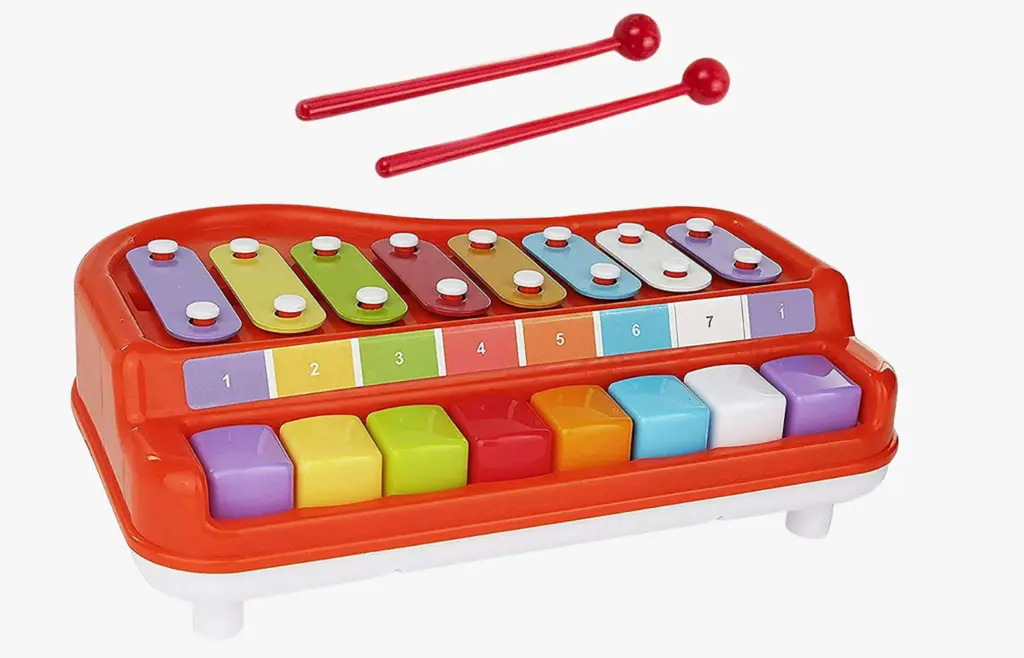
Why we love it!
- Dual Functionality
- Easy to Play
- Pleasant sound
- Cute Design
The Toysery 2-in-1 Piano Xylophone is a delightful and versatile musical instrument that offers the ability to play piano and xylophone at the same time! Combining the enchanting sounds of a xylophone with the playful features of a piano, this instrument sparks creativity and musical exploration in young minds.
I like that it comes with an easy-to-use little songbook. The notes are all color coordinated so it helps my little girl learn her colors and musical notes at the same time. By age 3 and into 4 years old she was playing simple melodies on the piano part all by herself.
Note: A few things that I didn’t love, but were not deal breakers. Because it is a 2-in-one model the piano part makes it necessary to have batteries. Also, the little songbook is designed to be propped behind the piano part but in front of the Xylophone so it makes it harder for my toddler to look at it while playing the xylophone part.
5. A Great Life Xylophone
A whole package of musical exploration!
Prepare to be enchanted by this accurately tuned kids’ xylophone set, complete with an array of delightful instruments for your young maestro.
This xylophone, or as they refer to it on their product page – glockenspiel features perfectly sized metal keys that produce crystal-clear notes, accompanied by two child-safe wooden mallet sticks.
It comes with a fun musical package including flutes, egg shakers, and bells, giving your child access to a harmonious symphony of sounds. Crafted from top-notch non-toxic materials, this toy ensures safety without compromising on quality. We like that their commitment to quality products is unwavering. They stand behind their products with a promise of a full refund or replacement if any concerns arise.
2 Xylophones to Avoid
Melissa & Doug Caterpillar Xylophone
Don’t be fooled by the good reviews this xylophone has on Amazon. It’s cute and it’s a good price, but we have found not only from testing it ourselves but from other parents that have bought this xylophone the sound of this one is not great.
Many parents have reported it being very out of tune. An out-of-tune xylophone makes listening to your little musician a bit unbearable. Especially if you are in the group of us that have perfect pitch.
Manhattan Toy Musical Chicken
It’s super cute and for anyone who loves chickens, this might be the xylophone for you! But in my opinion, the cute design isn’t for the price tag or the lack of functionality.
One of the drawbacks is that it offers fewer keys than other xylophones. This limitation could potentially restrict the range of musical exploration that toddlers can engage in. While the instrument still provides an opportunity for basic musical experimentation and coordination development, the fewer keys might not offer the same level of versatility and potential for learning as xylophones with a larger number of keys.
Key Features to Consider When Buying a Xylophone for Kids
When choosing a xylophone for your child, several key features should be taken into consideration to ensure an optimal playing experience. These features include:
Material and Durability
Look for xylophones made from high-quality materials that are durable and can withstand the enthusiastic play of children. Wooden or sturdy plastic xylophones are popular choices due to their durability and resonance.
Sound Quality
Consider the sound quality produced by the xylophone. Look for instruments that produce clear and pleasant tones, with a good resonance that captures the essence of the xylophone’s unique sound.
Size and Portability
Depending on your child’s age and intended usage, consider the size and portability of the xylophone. Smaller xylophones are suitable for younger children, while larger ones may provide more musical range and longevity.
Safety Features
Ensure that the xylophone has rounded edges and non-toxic materials, ensuring the safety of your child during play. Additionally, check for sturdy construction and stability to prevent accidents.

How to Choose the Right Xylophone for Your Child
When selecting a xylophone for your child, consider the following factors to ensure it is the right fit:
Age Appropriateness
Choose a xylophone that is suitable for your child’s age and developmental stage. Some xylophones are specifically designed for younger children with larger keys and simpler designs, while other xylophones cater to older kids with more complex musical arrangements.
Musical Range and Tones
Consider the musical range and tones of the xylophone. Some xylophones have a limited number of keys and a simplified scale, while others offer a wider range of notes, allowing for more musical exploration and creativity.
Ease of Use
Opt for a xylophone that is easy to play and user-friendly for your child. Look for features like labeled keys or color-coded notes to assist beginners in finding the correct keys and creating melodies.
Budget Considerations
Set a budget for your xylophone purchase and explore options within that range. There are xylophones available at various price points, so you can find a suitable instrument that meets your requirements without breaking the bank.
Tips for Teaching Kids to Play the Xylophone
Once you have chosen the perfect xylophone for your child, here are some tips to help you teach them how to play:
Start with Basic Melodies
Begin by teaching your child simple melodies using a few keys. Start with familiar tunes or nursery rhymes and gradually introduce new notes and songs as they progress. This approach builds their confidence and helps them develop a sense of accomplishment.
Encourage Experimentation
Allow your child to explore the xylophone and experiment with different combinations of notes. Encourage them to create their own melodies and rhythms, fostering their creativity and musical expression.
Provide Guidance and Support
Offer guidance and support during their practice sessions. Show them proper hand positioning and technique, and assist them in learning to read basic sheet music or playing by ear. Be patient and understanding as they navigate the learning process.
Make It Fun and Engaging
Incorporate games, musical activities, and interactive play to make learning the xylophone enjoyable for your child. Create rhythm patterns for them to mimic, engage in duets or group play, and encourage them to perform for family and friends.
Introducing children to music has been shown to have a positive impact on their overall development. It enhances cognitive skills, improves coordination, fosters creativity, and provides a means of self-expression. Xylophones, with their colorful keys and pleasant tones, are an excellent choice for young children to begin their musical journey. Not only do they offer an exciting and entertaining experience, but they also help in developing various essential skills. Let’s dive into the reasons why xylophones are great for kids.
Benefits of Music for Kids
Before we explore the specific benefits of xylophones, it’s essential to understand the broader advantages that music offers to children. Research has shown that music can enhance cognitive abilities, including memory, attention, problem-solving, and language skills. It also helps in developing emotional intelligence, improving social interactions, and boosting self-confidence. Additionally, music serves as a form of stress relief and promotes overall well-being.
Why Xylophones are Great for Kids
Enhancing Cognitive Skills
Playing the xylophone requires hand-eye coordination, concentration, and memory recall. As children strike different keys to produce specific notes, they engage multiple areas of their brain, strengthening neural connections and enhancing cognitive abilities. This activity stimulates their auditory and visual senses, improving their ability to perceive patterns and recognize melodies.
Developing Fine Motor Skills
The act of striking the xylophone keys with mallets helps children refine their fine motor skills. They learn to control their hand movements and develop precision in hitting the desired keys. This activity promotes finger dexterity and strengthens the muscles in their hands, which is crucial for future endeavors such as playing other musical instruments or engaging in activities that require manual coordination.
Introducing Musical Concepts
Xylophones provide an excellent platform for introducing basic musical concepts to children. By playing different keys and producing various tones, kids learn about pitch, rhythm, and melody. They start to understand the fundamental elements of music, such as high and low notes, tempo, and timing. This early exposure to musical concepts lays a strong foundation for their future musical endeavors.
Promoting Creativity and Expression
Xylophones offer an outlet for children to explore their creativity and express themselves through music. They can experiment with different combinations of notes, create their own tunes, and improvise melodies. This freedom to express their thoughts and emotions through music fosters their artistic abilities and nurtures their imagination.
Conclusion
Choosing the best xylophone for your child opens up a world of musical exploration and learning. The vibrant tones and engaging playability of xylophones make them an excellent choice for young children to develop their cognitive skills, fine motor abilities, and musical understanding. By considering key features such as material, sound quality, size, and safety, you can select a xylophone that suits your child’s age and preferences. With proper guidance, support, and a nurturing learning environment, your child can embark on a joyful musical journey with their xylophone.
FAQs
- What is the recommended age for a child to start playing the xylophone? The xylophone can be introduced to children as young as 2 or 3 years old. However, the complexity of the instrument may vary based on age, so choose an age-appropriate xylophone.
- Can a xylophone help develop a child’s coordination skills? Yes, playing the xylophone requires hand-eye coordination, fine motor skills, and concentration, which can aid in the development of a child’s coordination abilities.
- Are xylophones safe for young children? Xylophones designed for children typically have safety features such as rounded edges and non-toxic materials. However, adult supervision is still recommended, especially for younger children.
- Can a child learn to play melodies on a xylophone without any prior musical experience? Yes, children can learn to play melodies on a xylophone even without prior musical experience. With guidance, practice, and a basic understanding of the instrument’s layout, children can begin playing simple melodies and gradually progress to more complex tunes.
- How do I clean and maintain a xylophone? To clean a xylophone, use a soft cloth or brush to remove any dust or debris from the keys. Avoid using harsh chemicals or abrasive materials that could damage the instrument. Regular maintenance includes checking for loose or damaged keys, tightening screws if necessary, and storing the xylophone in a dry and safe place when not in use.
Now that you have a better understanding of the benefits of xylophones for kids and the key factors to consider when purchasing one, you can confidently choose the best xylophone that suits your child’s needs and preferences. Encourage their musical exploration, provide guidance and support, and watch as they embark on a joyful and enriching musical journey with their xylophone.
Disclaimer: This post may contain affiliate links. We only recommend high-quality products that are used and recommended by real musicians. If you use these links to buy something we earn a small commission.

